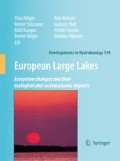Abstract
During the Fennoscandian ice recession from the eastern Baltic area, the water level in the Lake Peipsi basin was decreasing and reached a minimum at the end of the Younger Dryas Chronozone. The low lake level episode is represented in the basal deposits by a ca. 0.8 m thick bed of coarse detritus gyttja dated to 9.6–9.1 ka 14C BP. The gyttja lies at an elevation of 20–21 m a.s.l., i.e. about 9 m below the present lake level (30 m a.s.l.), and is buried under a 1.5–2 m bed of fine to medium-grained sand. The overall pollen data indicate a shallow-water littoral environment during the gyttja accumulation in the area studied. The diatom flora in the gyttja is dominated by shallow-water benthic and epiphytic taxa, indicating eutrophic littoral conditions at the time of gyttja accumulation. In the uppermost portion of the gyttja sequence the pollen and diatom successions indicate a short period of land emergence when swampy conditions prevailed in the surroundings.
Access this chapter
Tax calculation will be finalised at checkout
Purchases are for personal use only
Preview
Unable to display preview. Download preview PDF.
References
Battarbee, R. W., 1986. Diatom analysis. In Berglund, B. E. (ed.), Handbook of Holocene Palaeoecology and Palaeohydrology. Wiley & Sons Ltd., Chichester: 527–570.
Berglund, B. E. & M. Ralska-Jasiewiczowa, 1986. Pollen analysis and pollen diagrams. In Berglund, B. E. (ed.), Handbook of Holocene Palaeoecology and Palaeohydrology. Wiley & Sons Ltd., Chichester: 455–484.
Davydova, N. & K. Kimmel, 1991. Palaeogeography of the Lake Peipsi on the basis of biostratigraphical studies of bottom sediments. Proceedings of Estonian Academy of Sciences, Geology 40: 16–23.
Grimm, E., 1992. TILIA-TILIA*GRAPH Computer Program. Illinois State Museum.
Hang, E., T. Liblik & E. Linkrus, 1964. On the relations between Estonian valley terraces and lake and sea levels in the late glacial and Holocene periods. Transactions of the Tartu State University 156, Publications on Geography IV: 29–42.
Hang, T., A. Miidel & R. Pirrus, 1995. Late Weichselian and Holocene water-level changes of Lake Peipsi, eastern Estonia. PACT 50: 121–131.
Hang, T. & A. Miidel, 1999. Holocene history of the lake. In Miidel, A. & A. Raukas (eds.), Lake Peipsi Geology. Sulemees Publishers, Tallinn: 131–135.
Hang, T., A. Miidel, V. Kalm & K. Kimmel, 2001. New data on the distribution and stratigraphy of the bottom deposits of Lake Peipsi, eastern Estonia. Proceedings of the Estonian Academy of Sciences, Geology 50: 233–253.
Katz, N. Y., S. V. Katz & M. G. Kipiani, 1965. Atlas i opredelitel plodov i semyan vstrechayushchikhsya v chetvertichnykh otlozheniyakh SSSR. Nauka, Moscow: 366 pp (Atlas and keys of fruits and seeds occurring in the Quaternary deposits of the U.S.S.R (in Russian)).
Katz, N. Y., S. V. Katz & E. I. Skobejeva, 1977. Atlas rastitelnykh ostatkov v torfakh. Nedra, Moscow: 372 pp (Atlas of plant remains in peat (in Russian)).
Krammer, K. & H. Lange-Bertalot, 1986. Bacillariophyceae: Naviculaceae. Süsswasserflora von Mitteleuropa 2/1. Gustav Fisher Verlag, Stuttgart-New York.
Krammer, K. & H. Lange-Bertalot, 1988. Bacillariophyceae: Bacillariaceae, Epithemiaceae, Surirellaceae. Süsswasserflora von Mitteleuropa 2/2. Gustav Fisher Verlag, Stuttgart-New York.
Krammer, K. & H. Lange-Bertalot, 1991a. Bacillariophyceae: Centrales, Fragilariaceae, Eunotiaceae. Süsswasserflora von Mitteleuropa 2/3. Gustav Fisher Verlag, Stuttgart-New York.
Krammer, K. & H. Lange-Bertalot, 1991b. Bacillariophyceae: Achnanthaceae & Kritsche Ergänzerungen zu Navicula (Lineolatae) und Gomphonema. Süsswasserflora von Mitteleuropa 2/4. Gustav Fisher Verlag, Stuttgart-New York.
Mäemets, H., 2002. Commented list of macrophyte taxa of Lake Võrtsjärv. Proceedings of Estonian Academy of Sciences, Biology, Ecology 51: 5–25.
Mangerud, J., S. Andersen, B. Berglund & J. Donner, 1974. Quaternary stratigraphy of Norden, a proposal for terminology and classification. Boreas 3: 109–128.
Miettinen, A., 2002. Relative sea level changes in the eastern part of the Gulf of Finland during the last 8000 years. Annales Academiae Scientiarium Fennicae, Geologica-Geographica 162: 12–14.
Miidel, A., R. Noormets, T. Hang, T. Flodén & M. Bjerkéus, 2001. Bedrock geology and topography of the Lake Peipsi depression, eastern Estonia. GFF 123: 15–22.
Munsell Color Company, 1998. Munsell Soil Color Charts. Munsell Color, New York.
Niinemets, E., 1999. Ostracods. In Miidel, A. & A. Raukas (eds.), Lake Peipsi Geology. Sulemees Publishers, Tallinn: 90–97.
Raukas, A. & E. Rähni, 1969. On the geological development of the Peipsi-Pihkva depression and the basins distributed in that region. Proceedings of Estonian Academy of Sciences, Chemistry and Geology 18, 113–127 (in Russian).
Rosentau, A., 2006. Development of Proglacial Lakes in Estonia. Dissertationes Geologicae Universitatis Tartuensis 18, Tartu University Press, Tartu: 48 pp.
Sarv, A. & E. Ilves, 1975. Über das Alter der holozänen Ablagerungen im Mündungsgebiet des Flusses Emajõgi (Saviku). Proceedings of Estonian Academy of Sciences, Chemistry and Geology 24: 64–69.
Schoch, W. H., B. Pawlik & F. H. Schweingruber, 1988. Botanische makroreste. P. Haupt, Bern & Stuttgart: 205 pp
Author information
Authors and Affiliations
Corresponding author
Editor information
Editors and Affiliations
Rights and permissions
Copyright information
© 2007 Springer Science+Business Media B.V.
About this chapter
Cite this chapter
Hang, T., Kalm, V., Kihno, K., Milkevičius, M. (2007). Pollen, diatom and plant macrofossil assemblages indicate a low water level phase of Lake Peipsi at the beginning of the Holocene. In: Nõges, T., et al. European Large Lakes Ecosystem changes and their ecological and socioeconomic impacts. Developments in Hydrobiology, vol 199. Springer, Dordrecht. https://doi.org/10.1007/978-1-4020-8379-2_2
Download citation
DOI: https://doi.org/10.1007/978-1-4020-8379-2_2
Publisher Name: Springer, Dordrecht
Print ISBN: 978-1-4020-8378-5
Online ISBN: 978-1-4020-8379-2
eBook Packages: Biomedical and Life SciencesBiomedical and Life Sciences (R0)

